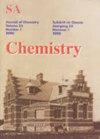Effervescence assisted dispersive liquid-liquid microextraction for spectrophotometry determination of chromium (VI) in water, tannery effluent, milk, and orange juice samples
IF 0.8
4区 化学
Q4 CHEMISTRY, MULTIDISCIPLINARY
South African Journal of Chemistry-Suid-Afrikaanse Tydskrif Vir Chemie
Pub Date : 2022-12-01
DOI:10.17159/0379-4350/2022/v76a18
引用次数: 0
Abstract
In this paper, effervescence-assisted dispersive liquid-liquid microextraction was proposed for selective extraction and preconcentration of Cr (VI) prior to its quantitative determination by UV-Vis spectrophotometry. Before employing the method, Cr (VI) ions available in the samples were complexed with 1,5-diphenylcarbazide in an acidic medium. Experimental parameters influencing the performances of the method including pH, the concentration of the complexing agent, type and volume of both extraction solvent and effervescent agent, stability of the complex, and effect of extraction time were thoroughly studied and optimized. Calibration curve plotted from 0.005-2.0 mg L-1 demonstrated good linearity (R2 = 0.9992). The limits of detection and quantification of the method were 0.001 and 0.005 mg L-1, respectively. The method provided an enrichment factor of 21.4. Precision studies in terms of repeatability, intermediate precision, and reproducibility were conducted at three concentration levels and their RSD values were <6.2. The ruggedness of the method studied at different wavelengths (535-545 nm) had RSD values <3.3. The recoveries of the method were from 83.0-117.6%. Finally, the proposed method was successfully applied for the determination of Cr (VI) from various matrices including tap, well, and river water; tannery effluent; milk; and orange juice samples.泡腾辅助分散液-液微萃取分光光度法测定水、制革废水、牛奶和橙汁样品中的铬(VI)
本文提出了在紫外-可见分光光度法定量测定Cr(VI)之前,采用泡腾辅助分散液-液微萃取法对Cr进行选择性萃取和预富集。在采用该方法之前,将样品中可用的Cr(VI)离子与1,5-二苯基咔唑在酸性介质中络合。对影响该方法性能的实验参数,包括pH、络合剂浓度、萃取溶剂和泡腾剂的类型和体积、络合物的稳定性以及萃取时间的影响进行了深入的研究和优化。在0.005-2.0 mg L-1范围内绘制的校准曲线显示出良好的线性(R2=0.992)。该方法的检测限和定量限分别为0.001和0.005 mg L-1。该方法提供了21.4的富集因子。在三个浓度水平下进行了重复性、中间精密度和再现性方面的精密度研究,其RSD值<6.2。在不同波长(535-545nm)下研究的方法的稳健性的RSD值<3.3。该方法的回收率为83.0-117.6%。最后,该方法成功地应用于自来水、井水和河水等各种基质中Cr(VI)的测定;制革废水;牛奶和橙汁样品。
本文章由计算机程序翻译,如有差异,请以英文原文为准。
求助全文
约1分钟内获得全文
求助全文
来源期刊
CiteScore
3.10
自引率
0.00%
发文量
6
审稿时长
>12 weeks
期刊介绍:
Original work in all branches of chemistry is published in the South African Journal of Chemistry. Contributions in English may take the form of papers, short communications, or critical reviews.

 求助内容:
求助内容: 应助结果提醒方式:
应助结果提醒方式:


